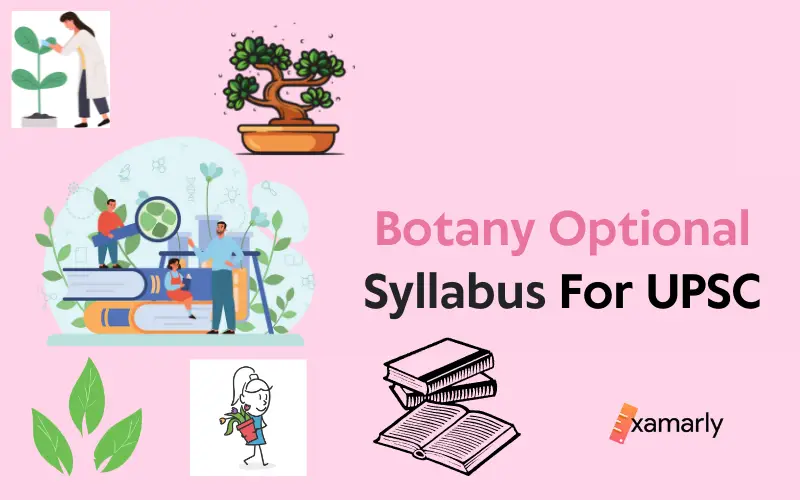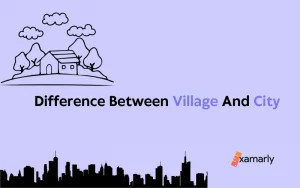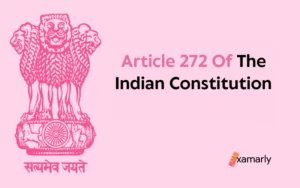Botany is one of the 48 optional subjects provided for choice in UPSC Mains Exam. The Botany optional syllabus for UPSC ranges from the theoretical to the practical. The candidate in Botany optional is tested on the basis of his/her ability to crosslink scientific knowledge of botany with problems of the society. Botany optional syllabus for UPSC thus becomes one of the easiest one to crack.
Detailed Syllabus for Botany Optional Subject Paper I & II for UPSC Mains Exam Is given below
Botany Optional Syllabus For UPSC : Paper 1
Microbiology and Plant Pathology:
Structure and reproduction/multiplication of viruses, viroids, bacteria, fungi and mycoplasma; Applications of microbiology in agriculture, industry, medicine and in control of soil and water pollution; Prion and Prion hypothesis.
Important crop diseases caused by viruses, bacteria, mycoplasma, fungi and nematodes; Modes of infection and dissemination; Molecular basis of infection and disease resistance/defence; Physiology of parasitism and control measures; Fungal toxins; Modelling and disease forecasting; Plant quarantine.
Cryptogams:
Algae, fungi, lichens, bryophytes, pteridophytes-structure and reproduction from evolutionary viewpoint; Distribution of Cryptogams in India and their ecological and economic importance.
Phanerogams:
Gymnosperms: Concept of Progymnosperms; Classification and distribution of gymnosperms; Salient features of Cycadales, Ginkgoales, Coniferales and Gnetales, their structure and reproduction; General account of Cycadofilicales, Bennettitales and Cordaitales; Geological time scale; Type of fossils and their study techniques.
Angiosperms: Systematics, anatomy, embryology, palynology and phylogeny.
Taxonomic hierarchy; International Code of Botanical Nomenclature; Numerical taxonomy and chemotaxonomy; Evidence from anatomy, embryology and palynology.
Origin and evolution of angiosperms; Comparative account of various systems of classification of angiosperms; Study of angiospermic families: Mangnoliaceae, Ranunculaceae, Brassicaceae, Rosaceae, Fabaceae, Euphorbiaceae, Malvaceae, Dipterocarpaceae, Apiaceae, Asclepiadaceae, Verbenaceae, Solanaceae, Rubiaceae, Cucurbitaceae, Asteraceae, Poaceae, Arecaceae, Liliaceae, Musaceae and Orchidaceae.
Stomata and their types; Glandular and non-glandular trichomes; Unusual secondary growth; Anatomy of C3 and C4 plants; Xylem and phloem differentiation; Wood anatomy.
Development of male and female gametophytes, pollination, fertilization; Endosperm – its development and function; Patterns of embryo development; Polyembroyony and apomixes; Applications of palynology; Experimental embryology including pollen storage and test-tube fertilization.
Plant Resource Development:
Domestication and introduction of plants; Origin of cultivated plants; Vavilov’s centres of origin; Plants as sources for food, fodder, fibre, spices, beverages,edible oils, drugs, narcotics, insecticides, timber, gums, resins and dyes, latex, cellulose, starch and its products; Perfumery; Importance of Ethnobotany in Indian context; Energy plantations; Botanical Gardens and Herbaria.
Morphogenesis:
Totipotency, polarity, symmetry and dfferentiation; Cell, tissue, organ and protoplast culture; Somatic hybrids and Cybrids; Micropropagation; Somaclonal variation and its applications; Pollen haploids, embryo rescue methods and their applications.
Botany Optional Syllabus For UPSC : Paper 2
Cell Biology
Techniques of cell biology; Prokaryotic and eukaryotic cells-structural and ultrastructural details; Structure and function of extracellular matrix (cell wall), membranes-cell adhesion, membrane transport and vesicular transport; Structure and function of cell organelles (chloroplasts, mitochondria, ER, dictyosomes ribosomes, endosomes, lysosomes, peroxisomes); Cytoskeleton and microtubules; Nucleus, nucleolus, nuclear pore complex; Chromatin and nucleosome; Cell signaling and cell receptors; Signal transduction; Mitosis and meiosis; Molecular basis of cell cycle; Numerical and structural variations in chromosomes and their significance; Chromatin organization and packaging of genome; Polytene chromosomes; B-chromosomes’ structure, behaviour and significance.
Genetics, Molecular Biology and Evolution:
Development of genetics; Gene versus allele concepts (Pseudoalleles); Quantitative genetics and multiple factors; Incomplete dominance, polygenic inheritance, multiple alleles; Linkage and crossing over; Methods of gene mapping, including molecular maps (idea of mapping function); Sex chromosomes and sex-linked inheritance, sex determination and molecular basis of sex differentiation; Mutations (biochemical and molecular basis); Cytoplasmic inheritance and cytoplasmic genes (including genetics of male sterility).
Structure and synthesis of nucleic acids and proteins; Genetic code and regulation of gene expression; Gene silencing; Multigene families; Organic evolution: evidences, mechanism and theories.
Plant Breeding, Biotechnology and Biostatistics:
Methods of plant breeding: introduction, selection and hybridization (pedigree, backcross, mass selection, bulk method); Mutation, polyploidy, male sterility and heterosis breeding; Use of apomixes in plant breeding; DNA sequencing; Genetic engineering ? methods of transfer of genes; Transgenic crops and biosafety aspects; Development and use of molecular markers in plant breeding; Tools and techniques – probe, southern blotting, DNA fingerprinting, PCR and FISH. Standard deviation and coefficient of variation (CV); Tests of significance (Z-test, t-test and chi-square test); Probability and distributions (normal, binomial and Poisson); Correlation and regression.
Related – Botany Optional For UPSC
Physiology and Biochemistry
Water relations, mineral nutrition and ion transport, mineral deficiencies; Photosynthesis-photochemical reactions; photophosphorylation and carbon fixation pathways; C3, C4 and CAM pathways; Mechanism of phloem transport; Respiration (anaerobic and aerobic, including fermentation)?electron transport chain and oxidative phosphorylation; Photorespiration; Chemiosmotic theory and ATP synthesis; Lipid metabolism; Nitrogen fixation and nitrogen metabolism; Enzymes, coenzymes; Energy transfer and energy conservation; Importance of secondary metabolites; Pigments as photoreceptors (plastidial pigments and phytochrome); Plant movements; Photoperiodism and flowering, vernalization, senescence; Growth substances-their chemical nature, role and applications in agri-horticulture; Growth indices, growth movements; Stress physiology (heat, water, salinity, metal); Fruit and seed physiology; Dormancy, storage and germination of seed; Fruit ripening?its molecular basis and manipulation.
Ecology and Plant Geography:
Concept of ecosystem; Ecological factors; Concepts and dynamics of community; Plant succession; Concept of biosphere; Ecosystems; Conservation; Pollution and its control (including phytoremediation); Plant indicators; Environment (Protection) Act.
Forest types of India-Ecological and economic importance of forests, afforestation, deforestation and social forestry; Endangered plants, endemism, IUCN categories, Red Data Books; Biodiversity and its conservation; Protected Area Network; Convention on Biological Diversity; Farmers? Rights and Intellectual Property Rights; Concept of Sustainable Development; Biogeochemical cycles; Global warming and climatic change; Invasive species; Environmental Impact Assessment; Phytogeographical regions of India.
Botany Optional Preparation Strategy
- Make a thorough Study plan. Include reference books from your 3 year Honors degree course in Botany.
- Follow the previous year question papers to gain further insight into the exam pattern.
- Some optional subjects deal with specialized disciplines. This is one such optional paper. Make sure you have a strong background in Plant Biology before taking up the Botany subject as optional.
- Attempt numerous mock tests. Increase your chances of selection by preparing beforehand.
- Arrange your study material into smaller chapters. Tread from an atomic viewpoint to a larger viewpoint.
Conclusion
Botany Optional syllabus for UPSC Mains is highly specialised and requires prior knowledge in the subject by the candidate. Therefore, it is advised that students who have had Botany in their college undergraduate, postgraduate or even higher programmes should take up botany. However, on the sunnier side, Botany is indeed very scoring due to its fact based nature. Candidates who have Botany optional for UPSC Exam should be able to make meaningful networks across economy, ecology and population sciences, etc. to avail the maximum benefit from answer writing.
See Also – The Ultimate Reading List for UPSC Botany for IAS & IFS Main
FAQs
Is Botany a good subject to take as optional subject in UPSC?
A good or a bad choice depends on the academic preferences of the candidate. All candidates are advised to align their optional subject with their area of interest to get the maximum benefit. For UG/PG students of Plant Science, Botany can yield the maximum benefits.
Is Botany a tough optional for UPSC?
The syllabus for optional in UPSC mainly covers areas from UG programs. Thus, it should not be tough for Botany students who have completed at least graduate level in Botany. However, a candidate with Botany optional would have to spend more time with GS and Essay paper since Botany has little or no overlap with those.
What are some of the best books for UPSC Botany Optional?
To get a curated booklist consisting of standard books for UPSC Botany, check out our other article, Botany Optional For UPSC.






